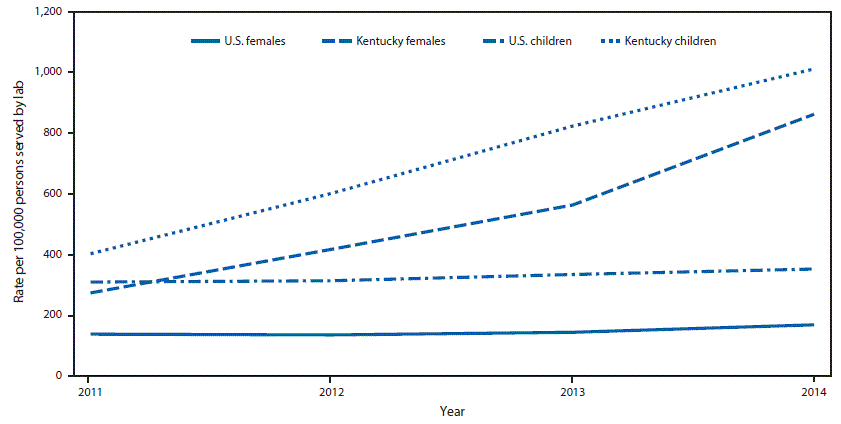Hepatitis C detection rises in young women and young children
A recent Centers for Disease Control Morbidity and Mortality Weekly Report found that mother-to-child (also known as vertical) hepatitis C (HCV) transmission rates are increasing nationally, but particularly in Kentucky.The new research emerged in part from a collaboration between CDC and Quest Diagnostics to study trends in hepatitis testing based on Quest's national database of de-identified test results. Experts from the Quest Diagnostics Health Trends™ team, which studies the company's national database to reveal trends on a range of health issues, participated with CDC investigators on the MMWR analysis.Hepatitis C is a serious liver infection caused by the hepatitis C virus (HCV). It is spread from person to person through contact with blood, and HCV can be transmitted from mother to newborn during childbirth. A person with HCV may not realize he or she is infected unless screened for it with a lab test.

Hepatitis C virus (HCV) detection rate among females aged 15–44 years and HCV testing rate among children aged ≤2 years —United States and Kentucky, 2011–2014* (*HCV detection rates were calculated as number of females aged 15–44 years who received a positive HCV antibody and/or RNA result per 100,000 females aged 15–44 years served by Quest Diagnostics (i.e., received a laboratory test for any reason) by area of residence. HCV testing rates among children were calculated as number of children aged ≤2 years who received a test for HCV antibody and/or RNA per 100,000 children aged ≤2 years served by Quest Diagnostics by area of residence. Source: Quest Diagnostics laboratory data.)In the study, which examined HCV detection rates from 2011-2014, HCV detection in women of child-bearing age increased 22 percent nationally, but rose dramatically to 213 percent in Kentucky. HCV detection rates among children less than two years old were up to 14 percent nationally and 151 percent in Kentucky during the same time period.During the time period in which the study was conducted, 777 pregnant women in Kentucky had HCV. More than one-third of these women also reported past or current injection drug use, which may be related to the increased transmission of HCV from mother to child. The study suggests nationally rising rates for vertical transmission of HCV. These rates and associated risk may be higher in areas of the United States where there are increased rates of injection drug use, such as Kentucky.Because not all HCV-infected mothers know their status, or may not disclose their status when they give birth, it can be difficult to link HCV-infected mothers to their babies. Some cities and states have already implemented practices to increase the accuracy of detection rates in mothers and their babies.For example, the Philadelphia Department of health improved identification of babies born to HCV-infected mothers by cross-matching maternal information on birth certificates to women in HCV surveillance registries. In Kentucky, the state government now requires reporting of all HCV-infected pregnant women and children through age five, as well as all babies born to all HCV-infected women.The new MMWR highlights the importance of prevention and screening for HCV. These practices, especially when implemented in women of childbearing age with or without suspected injection drug use, could increase early diagnosis and assist the mother and child with access to care and treatment.

Hepatitis C virus (HCV) detection rate among females aged 15–44 years and HCV testing rate among children aged ≤2 years —United States and Kentucky, 2011–2014* (*HCV detection rates were calculated as number of females aged 15–44 years who received a positive HCV antibody and/or RNA result per 100,000 females aged 15–44 years served by Quest Diagnostics (i.e., received a laboratory test for any reason) by area of residence. HCV testing rates among children were calculated as number of children aged ≤2 years who received a test for HCV antibody and/or RNA per 100,000 children aged ≤2 years served by Quest Diagnostics by area of residence. Source: Quest Diagnostics laboratory data.)In the study, which examined HCV detection rates from 2011-2014, HCV detection in women of child-bearing age increased 22 percent nationally, but rose dramatically to 213 percent in Kentucky. HCV detection rates among children less than two years old were up to 14 percent nationally and 151 percent in Kentucky during the same time period.During the time period in which the study was conducted, 777 pregnant women in Kentucky had HCV. More than one-third of these women also reported past or current injection drug use, which may be related to the increased transmission of HCV from mother to child. The study suggests nationally rising rates for vertical transmission of HCV. These rates and associated risk may be higher in areas of the United States where there are increased rates of injection drug use, such as Kentucky.Because not all HCV-infected mothers know their status, or may not disclose their status when they give birth, it can be difficult to link HCV-infected mothers to their babies. Some cities and states have already implemented practices to increase the accuracy of detection rates in mothers and their babies.For example, the Philadelphia Department of health improved identification of babies born to HCV-infected mothers by cross-matching maternal information on birth certificates to women in HCV surveillance registries. In Kentucky, the state government now requires reporting of all HCV-infected pregnant women and children through age five, as well as all babies born to all HCV-infected women.The new MMWR highlights the importance of prevention and screening for HCV. These practices, especially when implemented in women of childbearing age with or without suspected injection drug use, could increase early diagnosis and assist the mother and child with access to care and treatment.
Buy your own lab tests
Shop online for a Hepatitis C test - no doctor visit required for purchase





